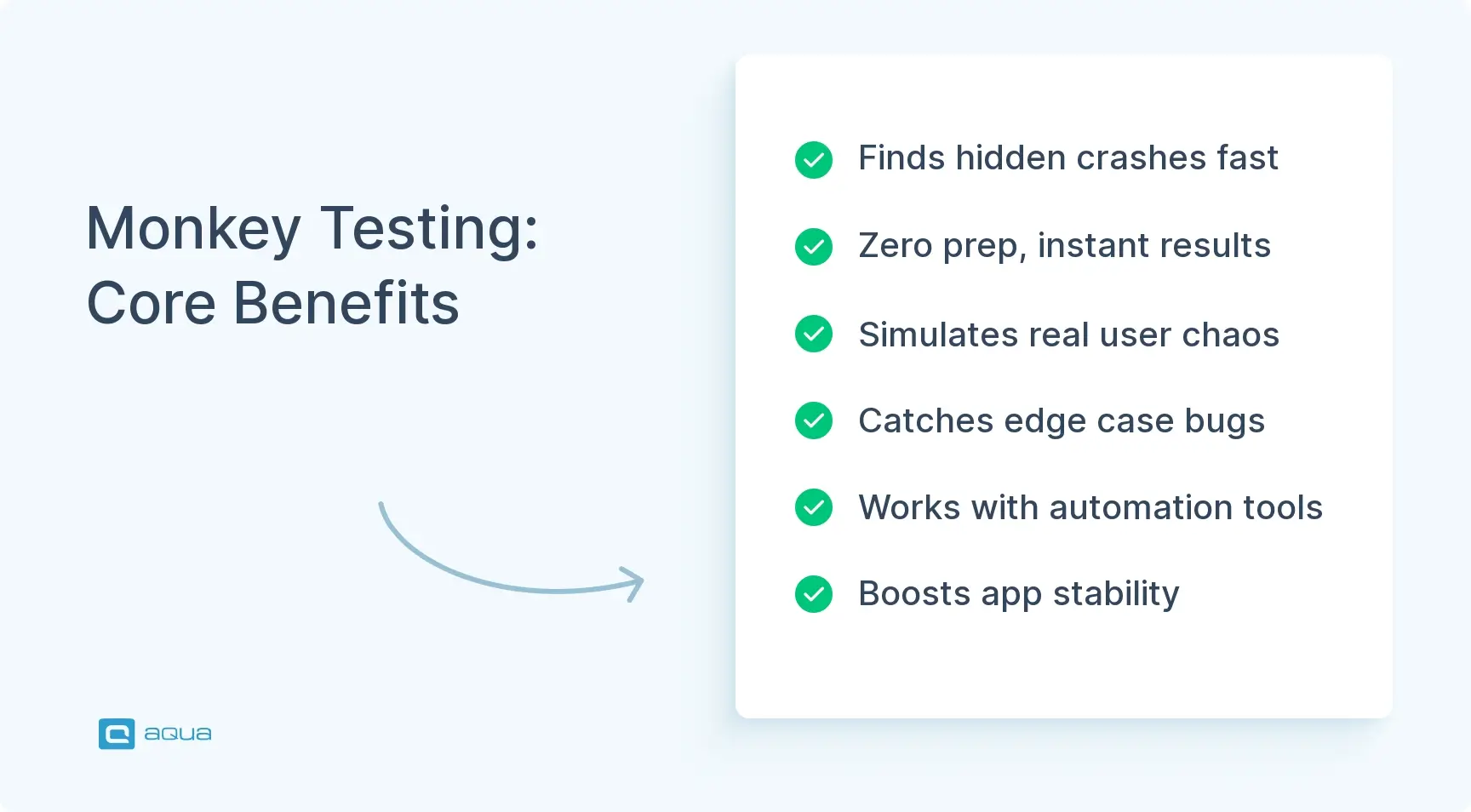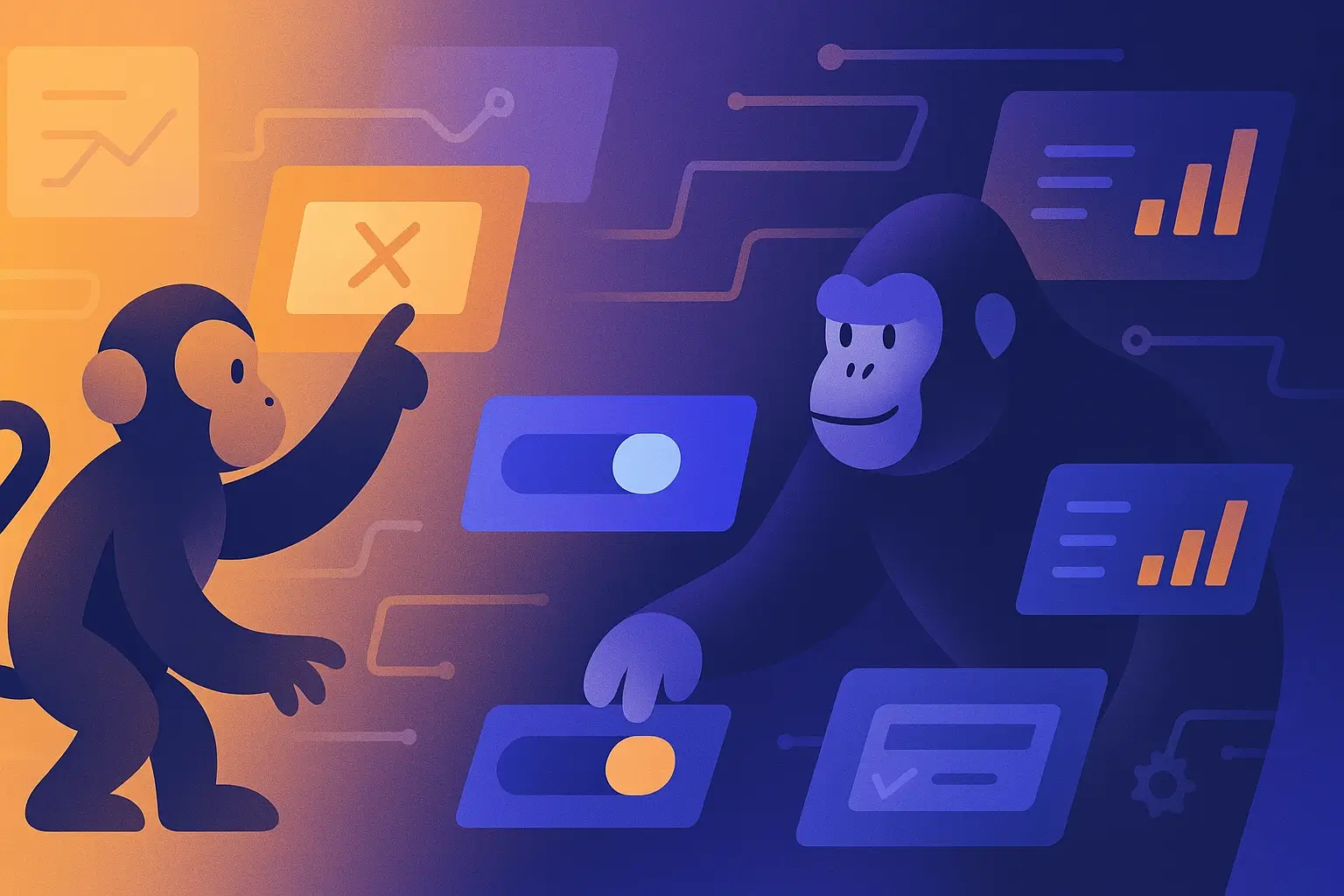Monkey Testing vs Gorilla Testing: Key Differences
You know the feeling when someone asks you to explain the difference between two things that sound similar but are actually polar opposites? That’s monkey testing and gorilla testing in a nutshell. The confusion is understandable. Both methods can uncover bugs that your standard test cases miss. But their approaches couldn’t be more different. Here’s the breakdown:
| Aspect | Monkey Testing | Gorilla Testing |
|---|---|---|
| Testing Approach | Random, chaotic, unstructured inputs | Focused, methodical, structured testing |
| Purpose | Find unexpected crashes and stability issues | Thoroughly test specific modules or components |
| Test Cases | No predefined test cases | Well-defined test cases and scenarios |
| Coverage | Wide but shallow coverage | Narrow but deep coverage |
| Duration | Can be brief or extended | Usually time-intensive |
| Tester Knowledge | Minimal domain knowledge required | Requires in-depth system knowledge |
| Automation | Easily automated | Partially automated but often manual |
| Bug Types Found | Unexpected crashes, edge cases | Functional issues, logical problems |
| When to Use | Early development, regression testing | Before major releases, critical module testing |
| Resources Needed | Minimal preparation, can use automation tools | Detailed test plans, skilled testers |
Now that you can see the stark differences, let’s dig into each approach. We’ll start with the wild card of the testing world, monkey testing, and explore exactly how throwing digital chaos at your app can reveal bugs you never knew existed.
What is Monkey Testing?
Monkey testing is a software testing technique where testers provide random inputs to the system without following any specific test pattern or methodology. The name comes from the concept of a monkey randomly hitting keys on a keyboard. It is chaotic, unpredictable, and without knowledge of what should happen.
It involves interacting with the application in unexpected ways, like clicking randomly, entering nonsensical data, or rapidly switching between functions, all to see if the application breaks under unpredictable usage patterns.
Key aspects of monkey testing include:
- Randomness: Inputs and actions are completely random and unpredictable
- Unstructured: No specific test cases or predefined scenarios to follow
- Goal-oriented: Primarily aims to find stability issues and crashes
- Automation-friendly: Can be automated with tools that generate random inputs
Monkey testing is particularly useful for:
- Finding unexpected crashes that wouldn’t be caught by structured testing
- Discovering edge cases that developers didn’t anticipate
- Testing application stability under chaotic conditions
- Simulating how inexperienced or unpredictable users might interact with your app
For example, a monkey test might involve a script that:
- Clicks random locations on a screen 1,000 times
- Enters random character strings into all available text fields
- Rapidly switches between app states and functions
- Performs multiple actions simultaneously that a typical user wouldn’t
Conducting a proper monkey test requires understanding that you’re deliberately trying to break the application through random inputs to uncover hidden vulnerabilities.
Features of Monkey Testing
Let’s say you’ve spent weeks perfecting your login flow, testing every possible username and password combination. Then, a user somehow manages to crash your app by rapidly tapping 47 different buttons while simultaneously rotating their phone. That’s exactly the kind of chaos monkey testing catches. Here’s what makes monkey testing surprisingly effective:
- Zero prep time means faster feedback: While your team argues over test case priorities, monkey testing is already finding bugs. No planning meetings, no documentation—just unleash the chaos and see what breaks.
- Finds the bugs users actually encounter: Real users don’t follow your careful test scripts. They fat-finger buttons, lose network connection mid-action, and somehow always find the one interaction you never considered.
- Perfect for that intern who just started: Hand them a monkey testing tool and they’re productive on day one. No need to understand complex business logic or user workflows.
- Catches embarrassing demo disasters: Nothing’s worse than your app crashing during a client presentation. Monkey testing finds those random crashes before your CEO does.
- Stress tests without the stress: Your app gets hammered with rapid-fire actions, revealing memory leaks and performance issues that only show up under pressure.
- Automation that actually saves time: Set it running overnight and wake up to a list of crashes to investigate. No human sitting there clicking buttons for hours.
- Complements your existing tests perfectly: Your structured tests check the happy path; monkey testing finds the paths you never knew existed.

Here’s the problem: you’re now running monkey tests automatically, planning gorilla testing for key features, and managing your regular test cases all at once. Your test results are everywhere: monkey test crashes in one tool, gorilla test reports in spreadsheets, and manual test results somewhere else. You might struggle to keep track of what’s been tested, what needs attention, and whether your testing strategy is actually working. This is where a good test management system becomes crucial.
This is exactly what aqua solves. Instead of dealing with multiple tools and losing track of test results, you get one central place where your monkey test crashes, gorilla testing documentation, and regular test cases all live together. When your automated monkey tests find issues, aqua’s native bug recording captures everything instantly, no more scrambling to reproduce crashes or losing critical error details. The AI-powered test generation means you can quickly create comprehensive gorilla test cases for your critical modules without spending days writing them manually. Plus, with full integration to your existing tools like Jira and Jenkins, your entire testing workflow stays connected, giving you complete visibility into what’s been tested, what’s failed, and what needs your attention next.
Master both monkey and gorilla testing with 100% AI-powered solution
The Real Impact of Monkey Testing
Let’s put you in a scenario where your e-commerce app just passed all functional tests. Payment flows work perfectly, product searches return accurate results, and the checkout process is smooth as silk. Your QA team gives the green light for the holiday season launch.
Three days after going live, customer support is flooded with crash reports. Users can’t complete purchases, the app freezes randomly, and your conversion rate plummets. The culprit? A memory leak is triggered when users rapidly switch between product categories while the search function is still loading. A scenario no one thought to test.
This is where monkey testing would have saved the day. By throwing thousands of random, rapid interactions at your app, it would discover the specific sequence of actions that causes the crash. Instead of losing revenue during your biggest sales period, you’d have caught and fixed the issue before launch.
The outcomes when monkey testing is part of your strategy:
- Prevents embarrassing production crashes that damage user trust and revenue
- Reveals memory leaks and performance issues under rapid user interactions
- Catches edge cases that structured testing never considers
- Builds confidence in your app’s stability before major releases
- Saves money by finding critical bugs before they reach customers
- Protects your reputation from “randomly crashing app” reviews
When monkey testing becomes part of your regular testing routine, you stop being surprised by user behaviour and start being prepared for it.
What is Gorilla Testing?
Gorilla testing refers to a thorough and intensive testing approach that focuses on a specific module or functionality. Unlike the random nature of monkey testing, gorilla testing is structured and methodical.
The name “gorilla” signifies the strength and intensity with which the testing is performed. Testers “beat on” the software module repeatedly with various test cases until they’re confident it can withstand any usage scenario.
This testing method deeply examines one component at a time, testing it repeatedly with different data sets, under various conditions, and from multiple angles. The goal is to ensure that the component is robust enough to handle all expected (and some unexpected) usage patterns without failing.
Gorilla testing typically involves:
- Creating comprehensive test plans for the target module
- Developing extensive test cases that cover all possible scenarios
- Testing the same functionality repeatedly with different data
- Examining the module under various system conditions (low memory, high CPU usage, etc.)
- Focusing on both positive and negative test scenarios
- Verifying boundary conditions and edge cases
- Ensuring the module integrates properly with other components
It is particularly valuable for mission-critical components where failure could have significant consequences.
While gorilla testing focuses deeply on specific modules, it forms an important addition to broader testing methods in a comprehensive QA strategy.
Features of Gorilla Testing
After understanding monkey testing’s chaotic approach, gorilla testing feels completely planned and strategic. Here, you can not rely on an intern to carry out your testing anymore. Instead of random attacks across your entire application, gorilla testing focuses on one specific module and dissects it completely.
Here are the key features that define gorilla testing:
- Single-module obsession: All testing energy focuses on one component at a time—your login system, payment processor, or search functionality gets undivided attention.
- Deep, methodical coverage: Every function, edge case, and data path within that module gets tested systematically, not just the happy path scenarios.
- Structured test case design: Unlike monkey testing’s randomness, gorilla testing uses carefully planned test scenarios based on business requirements and technical specifications.
- Multiple testing rounds: The same module gets tested repeatedly with different data sets, user conditions, and system states to ensure consistency.
- Expert-level domain knowledge required: Testers need a deep understanding of how the module works, its dependencies, and potential failure points.
- Extensive documentation: Detailed test plans, expected outcomes, and comprehensive bug reports are standard. Everything gets recorded and tracked.
- High resource investment: More time-intensive than broad testing approaches, requiring skilled testers and significant planning effort.
- Critical component prioritisation: Usually reserved for the most important parts of your system, the modules that absolutely cannot fail in production.
An intensive approach like this makes gorilla testing the opposite of monkey testing’s “spray and pray” philosophy. Where monkey testing covers wide ground quickly, gorilla testing digs deep into the components that matter most.
Why Gorilla Testing Matters
Now that you understand gorilla testing’s focused approach, let’s look at why this intensive method is worth the extra time and resources it demands.
Here are the key reasons why gorilla testing becomes essential:
- Prevents catastrophic failures in your most critical systems: When your payment processing or user authentication breaks, it doesn’t just affect one feature; it can bring down your entire business.
- Catches bugs that only surface under specific conditions: Some issues only appear when certain data combinations, user states, and system conditions align perfectly. Gorilla testing systematically tests these scenarios.
- Builds unshakeable confidence before major releases: After putting a module through gorilla testing, you can honestly tell stakeholders that it’s been thoroughly validated and is ready for production traffic.
- Validates complex business logic thoroughly: Modules with intricate calculations, multiple decision paths, or regulatory requirements need more than basic testing to ensure they work correctly in all situations.
- Creates comprehensive test documentation: The detailed test cases and results from gorilla testing become valuable assets for future releases, compliance audits, and onboarding new team members.
The bottom line: Gorilla testing is your insurance policy for the parts of your system that absolutely cannot fail. While it requires more investment upfront, it prevents the kind of production issues that can cost far more in lost revenue, damaged reputation, and emergency fixes.
The challenge with gorilla testing isn’t deciding whether to do it, it’s managing all the detailed test cases, tracking results across multiple testing rounds, and ensuring nothing falls through the cracks. When you’re testing the same critical module repeatedly with different data sets and conditions, organisation becomes everything. Aqua transforms this complex process into something manageable. Its AI-powered test generation creates comprehensive gorilla test cases in seconds and covers all those intricate scenarios and edge cases you need to validate. The centralised repository keeps all your detailed test documentation in one place, while full traceability shows you exactly which conditions have been tested and which still need coverage. When issues are found, the native bug recording captures every detail automatically, and with complete integration to your development tools, your team can track fixes and retest efficiently. Instead of drowning in spreadsheets and chaotic documentation, you get a clear picture of your critical module’s health and confidence that nothing important was missed.
Solve all your monkey and gorilla testing issues with 100% coverage and traceability
When to Use Monkey Testing vs Gorilla Testing
Here’s the million-dollar question: your release is in two weeks, you have three critical bugs to fix, and your QA team is asking whether to run monkey tests or focus on gorilla testing. What do you choose?
The answer depends entirely on your situation. Here’s your decision-making guide:
| Scenario | Monkey Testing | Gorilla Testing |
|---|---|---|
| Early development stage | ✓ Great for quick stability checks | Limited value until modules are stable |
| Pre-release validation | Limited value | ✓ Excellent for ensuring critical modules are production-ready |
| Limited testing resources | ✓ Provides good coverage with minimal resources | Not ideal due to resource intensity |
| Mission-critical components | Insufficient alone | ✓ Essential for thorough validation |
| UI/UX validation | ✓ Can find unexpected user flow issues | Less relevant unless focused on specific UI component |
| Regression testing | ✓ Can quickly identify new stability issues | ✓ Valuable for critical paths but too resource-intensive for all regression |
| Performance assessment | ✓ Good for stress testing | ✓ Good for analysing specific component performance |
| Security testing | Limited value | ✓ Valuable for security-critical modules |
| New feature testing | ✓ Quick initial stability check | ✓ Thorough validation once initial stability established |
| Mobile app testing | ✓ Particularly useful due to varied input methods | ✓ Important for core functionality |
Smart QA teams don’t see these as competing approaches because they layer them strategically. Use monkey testing early and often to catch obvious issues quickly, then deploy gorilla testing on your most critical components when you need absolute confidence in their reliability.
Making These Testing Methods Actually Work
Getting Monkey Testing Right:
The biggest mistake teams make? Running monkey testing once and calling it done. Set it up to run automatically after every major code change. You want to catch regressions immediately, not three weeks later during manual testing.
Make sure you’re capturing detailed logs of exactly what sequence of actions triggered each crash. There’s nothing more frustrating than knowing your app crashed during monkey testing but having no idea how to reproduce it.
Start small: run 15-minute sessions initially, then work up to longer periods as your app proves stable. And consider “smart” monkey testing that won’t waste time on obviously impossible actions like trying to scroll on a static image.
Making Gorilla Testing Count:
Don’t gorilla test everything. You’ll burn through your timeline and budget. Focus on the modules that would cause the most damage if they failed: payment processing, user authentication, data synchronisation.
Write your test cases before you start testing, not during. Include the weird edge cases your users will inevitably find—what happens when someone enters a 500-character name, or tries to process a payment for $0.01?
Test under realistic conditions, not just your perfect development environment. Run your tests when the system is under load, when memory is low, and when the network is spotty. That’s when the real bugs surface.
The key to both approaches: don’t treat them as one-time activities. Monkey testing should be part of your continuous integration pipeline, while gorilla testing should happen before every major release for your critical components.
Conclusion
The reality is simple: you will be able to deliver great software only if you can embrace chaos and control in equal measure. While your structured test cases cover the scenarios you can imagine, monkey testing reveals the ones you can’t, and gorilla testing ensures your most critical components can handle whatever users throw at them. The teams shipping the most reliable software aren’t debating which approach is better. They’re strategically deploying both to create applications that don’t just work in perfect conditions, but thrive in the messy, unpredictable real world. And believe us, the real world is where users click frantically, networks fail at the worst moments, and that “impossible” edge case somehow becomes your most common support ticket.


















